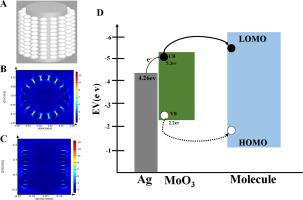Spectrochimica Acta Part A: Molecular and Biomolecular Spectroscopy ( IF 4.3 ) Pub Date : 2020-06-18 , DOI: 10.1016/j.saa.2020.118611 Tengda Shi 1 , Pei Liang 1 , Xiubing Zhang 1 , De Zhang 2 , Haibo Shu 1 , Jie Huang 1 , Zhi Yu 2 , YongQuan Xu 3

|
An ex situ method was used to synthesize noble metals and metal oxide composite materials, due to the selective adsorption properties of metal oxides, the adsorption of different probe molecules by this composite structure had been studied. In the ex situ approach, we use (3-aminopropyl) diethoxy methylsilane (ATES) as a coupling agent which is easy for noble metal nanoparticles deposited on metallic oxide nanomaterials. The Raman scattering (SERS) substrate of 1D MoO3 nanowires (MoO3-NWs) @Ag nanoparticles (Ag-NPs) hybrid surface had been fabricated. Several parameters are presented in the following which influences the morphology of self-assembly and SERS activity: (i) coupling agent of ATES, (ii) ATES content (iii) Ag-NPs content. The finite difference time domain (FDTD) method is to explain the enhancement mechanism distribution of the hybrid substrate. Different probe molecules (R6G, Methylene Blue, Crystal Violet, and 4-ATP) have been adsorbed for SERS tests. Improved principle component analysis (PCA) is adopted to obtain the minimum detection limit of probe molecules. Through the DFT calculation, different absorption strengths between the target molecules and the MoO3(010) surface have been illustrated, which is also the main reason for the selective enhancement effect of MoO3@Ag hybrid nanostructures. This paper might propose a method to prepare such enhancement substrate based on the selective absorption properties of oxide semiconductors.
中文翻译:

MoO3 @ Ag杂化纳米结构的协同增强作用可提高选择性检测的灵敏度。
利用异位合成金属和金属氧化物复合材料的方法,由于金属氧化物的选择性吸附特性,研究了该复合结构对不同探针分子的吸附作用。在非原位方法中,我们使用(3-氨基丙基)二乙氧基甲基硅烷(ATES)作为偶联剂,这对于沉积在金属氧化物纳米材料上的贵金属纳米颗粒而言很容易。一维MoO 3纳米线(MoO 3的拉曼散射(SERS)衬底-NWs)@Ag纳米粒子(Ag-NPs)杂化表面已被制造。以下介绍了几个参数,这些参数会影响自组装和SERS活性的形态:(i)ATES偶联剂,(ii)ATES含量(iii)Ag-NPs含量。时域有限差分法(FDTD)是用于解释混合基板的增强机理分布。不同的探针分子(R6G,亚甲基蓝,结晶紫和4-ATP)已被吸附用于SERS测试。采用改进的主成分分析(PCA)获得探针分子的最小检测限。通过DFT计算,说明了目标分子与MoO 3(010)表面的不同吸收强度,这也是MoO选择性增强作用的主要原因3 @Ag杂化纳米结构。本文可能会提出一种基于氧化物半导体的选择性吸收特性制备此类增强基板的方法。











































 京公网安备 11010802027423号
京公网安备 11010802027423号